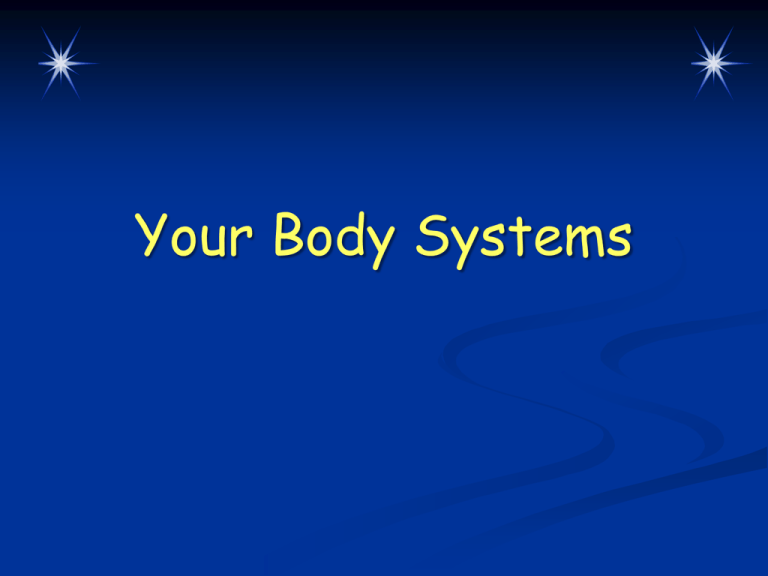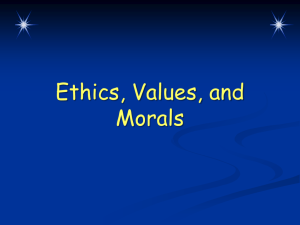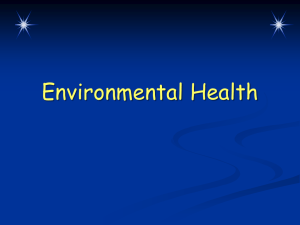LE100_PPT_C3_L1
advertisement

Your Body Systems Warm-Up Questions CPS Questions 1-2 Chapter 3, Lesson 1 Chapter Overview Lesson 1: Your Body Systems Lesson 2: Nutrition Lesson 3: The Benefits of Physical Activity Lesson 4: Understanding Your Body Image Lesson 5: First Aid Chapter 3, Lesson 1 Lesson Overview Functions of the human skeletal system How your muscular system works The human circulatory system The human respiratory system How the nervous system and sense organs work The human digestive system The body’s waste disposal system Chapter 3, Lesson 1 Quick Write The human body is made up of several different systems that work together as one unit. What do you think is the most amazing thing about how your body works? (Note to teacher: Use “Pick a Student” button in CPS) Chapter 3, Lesson 1 Photo Courtesy of Fotolia The Human Skeletal System Your body’s framework Three main functions: Support and protection Movement Storage and production of materials Chapter 3, Lesson 1 Photo Courtesy of Fotolia Kinds of Bones Your body has more than 200 bones Four basic kinds of bones Long bones Short bones Flat bones Irregular bones Long bones have larger ends that form a joint with another bone Chapter 3, Lesson 1 Photo Courtesy of Fotolia Caring for Your Skeletal System Eat food with nutrients and vitamins Phosphorus is in dairy products, dark green leafy vegetables, beans, and whole grains Milk is fortified with vitamin D and contains calcium Do regular physical activity to strengthen bones Chapter 3, Lesson 1 Photo Courtesy of Fotolia Activity 1: The Skeletal System Review the section in your textbook on the functions of the human skeletal system Complete the table to describe the three main functions of the skeletal system and answer the questions Chapter 3, Lesson 1 Types of Muscles Smooth Skeletal Cardiac Chapter 3, Lesson 1 Photo Courtesy of Fotolia The Muscular System All body movements depend on muscles Your body has about 600 muscles Exercise and healthy eating are important for good muscle tone To keep your muscles strong and healthy, do daily regular physical activity Chapter 3, Lesson 1 Photo Courtesy of Fotolia Learning Check Questions CPS Questions 3-4 Chapter 3, Lesson 1 Activity 2: Muscle Injuries Research and locate a news article about a specific muscle injury Identify the injury, medical evaluation, and treatment Take notes and answer the question Chapter 3, Lesson 1 The Human Circulatory System Your body’s transportation system Blood carries food and oxygen to every cell Blood is made up of: Red blood cells White blood cells Platelets Chapter 3, Lesson 1 Photo Courtesy of Fotolia The Human Circulatory System, cont. Your heart pumps blood to all parts of your body Average heart beats 72 times a minute Blood vessels distribute blood throughout your body Three kinds of blood vessels Arteries Capillaries Veins Chapter 3, Lesson 1 Photo Courtesy of Fotolia Preventing High Blood Pressure Need to keep a certain level of blood pressure for proper blood circulation Maintain a healthy weight through a healthy diet Exercise regularly Avoid tobacco, alcohol, and drugs Chapter 3, Lesson 1 Photo Courtesy of Fotolia Activity 3: The Circulatory System Review the section in your textbook on the human circulatory system Answer the questions Chapter 3, Lesson 1 The Human Respiratory System Brings a constant supply of oxygen from air into your body Gets oxygen into your body Also gets rid of carbon dioxide, a waste product Chapter 3, Lesson 1 Photo Courtesy of Fotolia Learning Check Questions CPS Questions 5-6 Chapter 3, Lesson 1 Activity 4: The Respiratory System Review the section in your textbook on the respiratory system Match each term to its correct definition Answer the questions Chapter 3, Lesson 1 The Nervous System Central nervous system Made up of the brain and the spinal cord The brain has three main parts: the cerebrum, cerebellum, and brain stem Peripheral nervous system Carries messages between your brain and spinal cord and the rest of your body Chapter 3, Lesson 1 Photo Courtesy of Fotolia The Sense of Sight Light enters the eye through the cornea The cornea sends the light to the pupil The lens helps direct the light energy onto the retina Entire process happens faster than you can blink Chapter 3, Lesson 1 Photo Courtesy of Fotolia The Sense of Hearing Outer ear picks up air vibrations and sends them to your eardrum Your brain interprets the message and tells you what kind of sound you have heard All of this happens in the time it takes for the sound to be made Chapter 3, Lesson 1 Photo Courtesy of Fotolia The Senses of Smell and Taste Nose Receptor cells send messages through nerves Can pick up thousands of different odors Tongue Can recognize only four kinds of taste: sweet, salty, sour, and bitter Chapter 3, Lesson 1 Photo Courtesy of Fotolia The Sense of Touch Your skin is your body’s largest organ Sense receptors all over your skin receive different sensations Sense receptors send messages through the nerves to your spinal cord and brain Chapter 3, Lesson 1 Photo Courtesy of Fotolia Activity 5: The Brain and the Senses Review the section in your textbook on how the nervous system and sense organs work Complete the tables to describe the functions and other characteristics of the brain and senses Chapter 3, Lesson 1 The Human Digestive System The digestive system breaks down food for your body’s use Chewing is part of mechanical digestion The enzyme in saliva begins to break down the food chemically Food stays in your stomach for three to four hours Chapter 3, Lesson 1 Photo Courtesy of Fotolia Diabetes One of the most serious medical issues Americans face today Type I Cells in the pancreas are not able to produce insulin Type II Pancreas makes insulin but your body cells cannot use the insulin properly Chapter 3, Lesson 1 Photo Courtesy of Fotolia Learning Check Questions CPS Questions 7-8 Chapter 3, Lesson 1 The Body’s Waste Disposal System Waste products must be removed from the body The body disposes of waste solids and liquids through the excretory system Solid material is removed through the large intestine Liquid material is removed through the kidneys Chapter 3, Lesson 1 Photo Courtesy of Fotolia Activity 6: The Digestive and Excretory Systems Review the sections in your textbook on the human digestive system and the body’s waste disposal system Label the diagrams and answer the questions Chapter 3, Lesson 1 Summary Functions of the human skeletal system How your muscular system works The human circulatory system The human respiratory system How the nervous system and sense organs work The human digestive system The body’s waste disposal system Chapter 3, Lesson 1 Review Questions CPS Questions 9-10 (Note to teacher: Use “Pick a Student” button in CPS) Chapter 3, Lesson 1 Next…. Done – your body systems Next – nutrition Chapter 3, Lesson 1 Photo Courtesy of Fotolia




